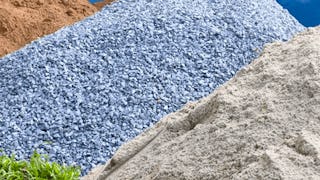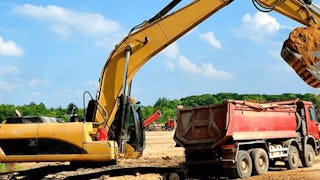Concrete production involves selecting and mixing raw materials—cement, water, fine and coarse aggregates—in precise proportions to achieve desired strength and durability. The process includes batching, thorough mixing, and transporting the concrete in rotating drum trucks to prevent premature setting. At the construction site, concrete is poured into molds, vibrated to remove air bubbles, and then cured under controlled conditions to harden and gain strength. This careful process ensures the creation of a durable and versatile material for various construction applications.



Production of concrete
This course is part of Mastering Concrete Techniques Specialization

Instructor: Subject Matter Expert
Access provided by Coursera Learning Team
Recommended experience
What you'll learn
Understand the role of cement, water, and aggregates in concrete production and their precise proportions for desired properties
Learn the importance of uniform mixing, transport logistics, pouring techniques, and curing for strength and durability
Gain insights into the precision and complexity required to produce effective, long-lasting concrete in construction
Details to know

Add to your LinkedIn profile
4 assignments
March 2025
See how employees at top companies are mastering in-demand skills

Build your subject-matter expertise
- Learn new concepts from industry experts
- Gain a foundational understanding of a subject or tool
- Develop job-relevant skills with hands-on projects
- Earn a shareable career certificate


Earn a career certificate
Add this credential to your LinkedIn profile, resume, or CV
Share it on social media and in your performance review

There are 4 modules in this course
The blending of aggregates in concrete construction involves the careful combination of various types and sizes of materials to achieve a well-graded and homogeneous mixture. This process is crucial in optimizing the overall performance of concrete, as different aggregates contribute unique characteristics to the final product. The selection of aggregates, such as crushed stone, gravel, or sand, is based on factors like particle size distribution, shape, and specific engineering requirements. By blending aggregates with different properties, engineers can enhance the workability, strength, and durability of the concrete mix. Achieving the right blend ensures proper compaction and cohesion within the concrete, resulting in a cohesive, well-structured material suitable for diverse construction applications, from foundations to structural elements. The blending of aggregates is a nuanced aspect of concrete mix design, directly influencing the overall quality and functionality of the construction material
What's included
15 videos1 assignment
Mix design in concrete is a systematic process that involves determining the proportions of ingredients to create a concrete mix with desired properties and performance characteristics. This meticulous process considers various factors to achieve the optimal combination of cement, aggregates, water, and admixtures. The primary objectives of mix design include achieving the required strength, durability, workability, and other specified properties based on the project's structural and environmental requirements. Engineers assess the properties of individual components, such as the gradation of aggregates, characteristics of cement, and the impact of admixtures, to formulate a well-balanced and cost-effective concrete mix. Mix design is a critical aspect of concrete technology, ensuring that the resulting material meets structural, durability, and aesthetic standards for diverse construction applications.
What's included
8 videos1 assignment
Testing of concrete ensures it meets strength, durability, and performance standards. Key tests include compressive strength for load-bearing capacity, slump tests for workability, and density tests for material weight and porosity. Additional tests evaluate flexural and tensile strength for resistance to bending and stretching, and durability tests assess resistance to environmental conditions. These evaluations confirm the concrete's reliability and suitability for construction
What's included
14 videos1 assignment
A batching plant, or concrete mixing plant, combines aggregates, cement, water, and admixtures to produce concrete in a controlled environment. It includes storage bins, conveyors, a mixer, and control equipment. Available in stationary and mobile designs, batching plants ensure consistent, high-quality concrete production, improving efficiency and quality control in construction projects.
What's included
7 videos1 assignment
Instructor

Offered by
Why people choose Coursera for their career




Recommended if you're interested in Physical Science and Engineering

L&T EduTech

L&T EduTech

L&T EduTech

Open new doors with Coursera Plus
Unlimited access to 10,000+ world-class courses, hands-on projects, and job-ready certificate programs - all included in your subscription
Advance your career with an online degree
Earn a degree from world-class universities - 100% online
Join over 3,400 global companies that choose Coursera for Business
Upskill your employees to excel in the digital economy



